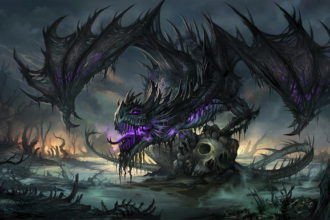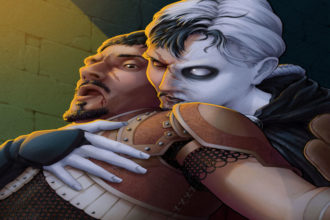A Lich for Every Class: The Paths of Transcendence (Part 2)

This is the second part of a multi-part series about the character classes developing until they become ‘lich-like;’ that is, following the path of their power until they become something more or less than human. You can read the first part here. To summarize:
The Path of the Lich – Wizards ‘kill’ their bodies and senses to free their mind in order to better study & master the arcane.
The Path of the Imbued – Fighters transfer their consciousness into favored weapons and armor enabling them to war throughout the centuries.
The Path of the Herald – Clerics sacrifice their personalities and identities as they become the physical embodiment/mirror for their chosen divinity.
The Path of the Whisper – Rogues merge with the shadows & their misdirections to become rumors cloaked in unseeing.
In this post, we’ll lay out descriptions for four additional classes: the barbarian, the bard, the druid, and the witch.
The Unbowed | The Path of the Barbarian
While fighters fixate on their skills and equipment (and thus lose their bodies), Barbarians know that underneath all the lies, trickery, and artifice of ‘civilized’ warriors lies strength and rage and the the will to keep going where other give in & fall. To give yourself fully to the fury, to finally abandon any notion that there is anything higher or holier than war-lust, to transform your body into the perfect conduit for rage; that is the Path of the Unbowed.
Unbowed Barbarians are usually encountered naked… though opponents discover their skin is harder than plate mail. If they are cut, they bleed out in great steaming gouts which can burn the unwary; their bodies heated to near boiling so that snow melts with their every step.
Unbowed Barbarians claim tremendous ranges as their territory, challenging man, beast or spirit alike to battle (it is said that a weapon wielded by one of these creatures can cut anything, even the incorporeal). Alternately, they act as defenders of their tribe, immortal protectors who -even if cut to pieces by their enemies- will reconstitute to rage again. The only way to permanently kill a Unbowed Barbarian is to keep them from fighting for a full month. Without a target for their blazing rage their fury twists in on itself as their bodies bubble and boil down to goo & charred bone.
What’s Given Up: The ability to operate in any state that isn’t rage.
What’s Gained: Natural AC, enhanced abilities to pierce through illusions/mind control, increased strength/ferocity, regeneration, ‘thorn’ like reflection of wounds, an attack that can hurt anything, immortality (as long as they keep fighting)
The Story | The Path of the Bard
All Bards are tellers of tales. Even those that sing, or dance, or play the harp weave together a ‘story’ which move the audience. There is one particular story they can tell however, one powered by the most potent and secret bardic magics that wholly transforms them; that replaces the reality of who they are by the perception of them, by the tales told about them. This story is the story of themselves. That is, the story of them becoming a Story.
The preparations for a Bard to follow the path of the Story are intricate and exacting; no less so than a wizard’s path to lichdom. They must spread the tale of themselves as far and wide as possible (and it usually helps to have a list of great deeds accomplished in their mortal life). Then, the step that most often is impossible for Bards, they must consciously begin to fade; traveling in disguise only to ensure the tale is still being shared – perhaps occasionally appearing suddenly as a larger than life figure to reinforce their legend. When they are sure that the story, their story has sufficient purchase in the world they then retreat to isolation, spend weeks telling the tale of their whole life without ceasing; embellishing here, tweaking a detail here. This telling is aided by the base magic of tale and song and music and art-making. With every word or note one more detail of the bard’s reality winks out of being while their story, the Story grows realer, richer, fuller in the mind of the tellers. Now disembodied, the Bardic Story knows where it is being recited and can choose to incarnate at any telling point of its choosing; often selecting those spots where it is most likely to add the next, best verse to its legend.
Bardic Stories are beings that flit into and out of existence as they are talked about. Wherever their story is told, they can manifest. They take on different trappings depending on local flavor, may -eventually- fork into two or more beings if their tale diverges enough. But even if their physical form is slain on an adventure, they can always come back anywhere they are being spoken of. Reality warps around a Bardic Story, details changing and tweaking to fit in with tropes and the structure most pleasing to narratives and art-making.
What’s Given Up: Any kind of ordinary identity/life
What’s Gained: Ability to travel incredible distances, legendary inspirations/ability to inspire, reality warping abilities related to story structure/tropes, immortality (as long as any remain alive who still tell the tale)
The Gnarl | The Path of the Druid
To a Druid, there is no higher god than the natural world. And each in their own way give themselves over to the protection, over to the love of nature. For some Druids however, loving/giving themselves over to the natural world at large is too impersonal. Rather, for these Druids they choose a particular ecosystem (a distinct forest, or desert, or sea or -more rarely- an ecosystem that they helped guide into existence from its inception)) to pour themselves into wholly. And so they become a Gnarl; a knot of disembodied spirit that serves as spokesperson and guide for an environment for ages to come.
Only advanced Druids can become Gnarls, and only by loving a particular natural place more than life itself is this possible. While still in their physical prime, a powerful Druid who would become a Gnarl calls upon the most primeval Druidic chants as he lays down in the center of their beloved. Over the course of weeks while professing their undying devotion they let the earth, the vines, and the creatures of the place do what they will to the Druid’s body. And as they are eaten, or buried in the earth, or as they rot their spirit leaks out and infuses the environment.
Thereafter, they can feel every leaf, see through every eye of every creature. A Gnarl can then manifest as a man-shaped tangle of roots or a confusion of animal fur and varied animal limbs wielding the most potent Druidic magics against any enemy. At this point, they speak for the environment’s interests over and above any other.
What’s Lost: Any self identification with the individual’s former life. A body
What’s Gained: Immortality as long as the chosen ecosystem ‘lives,’ more powerful Druidic magic, ability to manifest anywhere instantly (or even manifest multiple places) within an environment, near complete control of every living being within an environment.
(Check out the Fungal Sieve to see a detailed description of a particular Gnarl)
The Protrusion | The Path of the Witch
Scholars argue how to best explain the distinction between gods and patrons. Certainly the deals they make with mortals differ, and they vary in power and temperament and relate-ability. But only those most versed in lore know the actual truth at the core of the distinction; that all the gods that are or will be have bound themselves to causality, to the 4 dimensional flow of one event to another. Each patron (to a greater or lesser degree) agreed to no such accord and their power flows into and out of the weave of space-time as they will. And in following the path of the Protrusion Witches & Warlocks emulate their benefactors.
To be a Witch is to learn of the ties that bind. With a pact made and sealed, a witch ties a string around her heart to her patron. As she grows in power, other strings are tied until the patron and Witch dance together like sentient marionette and unseen puppeteer. And then the strings thicken, form knots within the body of the witch. More and more of what the Witch was is replaced by these strings which the Witch ultimately discovers to be extensions of their patron itself till they are functionally more a Protrusion of the extra-dimensional master than they are their own. And, just as the patron’s essence is gaining purchase in the world via the knots in the Witch’s flesh, so too the Witch’s presence can flow up the strings to their patron who perches outside the weave of causality. From this vantage point, in enabling their patron’s will a Protrusion can hop in and out of time & place, can slay enemies before they are born, cast spells before they were needed, and ultimately begin to fray the weave of space-time which keeps their patron’s power in check.
What’s Lost: Increasing Autonomy, accurate memories of the individual, any kind of relate-ability
What’s Gained: The ability to cast spells + use abilities retroactively, altering cannon\causality, increased Witch powers.
—
Anyway that’s four more done. The ‘Protrusion’ is obviously the most different and required me to give patrons a particular spin to make it work (and further differentiate it from Clerics\gods) and it might not work for everyone but I like it. I still plan to do a version for the 4 remaining 5e classes. Obvious idea for the sorcerer is some kind of magical conduit but I’m also tempted to do something that resembles the wizard-lich but ultimately feels like a different path. For the Monk, I’m tempted to do a gameable version of enlightenment where they lose all identity/achieve ‘no-mind’ but it’s not quite solidified in my head. Paladin/Rangers are still the ones I’m not sure about, mostly because their powers are a mix of martial/magical and seem derive from similar sources (namely, their obsessions – the oath for the paladin and the hunt for the ranger) but I’m going to read up on the classes for inspiration (possibly even reviewing the History of the Classes series for Paladin & Ranger for inspiration and building off of that).
But what do you think?
Could you see yourself playing one of these in a game?
Which do you think would make the best villain?
Sound off in the comments.



